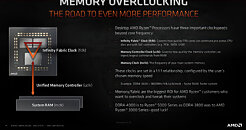Friday, October 16th 2020

AMD Ryzen 5000 Series Features Three Synchronized Memory Clock Domains
A leaked presentation slide by AMD for its Ryzen 5000 series "Zen 3" processors reveals details of the processor's memory interface. Much like the Ryzen 3000 series "Matisse," the Ryzen 5000 series "Vermeer" is a multi-chip module of up to 16 CPU cores spread across two 8-core CPU dies, and a unified I/O die that handles the processor's memory-, PCIe, and SoC interfaces. There are three configurable clock domains that ensure the CPU cores are fed with data at the right speed, and to ensure that the MCM design doesn't pose bottlenecks to the memory performance.
The first domain is fclk or Infinity Fabric clock. Each of the two CCDs (8-core CPU dies) has just one CCX (CPU core complex) with 8 cores, and hence the CCD's internal Infinity Fabric cedes relevance to the IFOP (Infinity Fabric over Package) interconnect that binds the two CCDs and the cIOD (client I/O controller die) together. The next frequency is uclk, or the internal frequency of the dual-channel DDR4 memory controller contained in the cIOD. And lastly, the mclk, or memory clock is the industry-standard DRAM frequency.The three clock domains, according to AMD, are in a 1:1:1 synchrony, i.e. DRAM SDR clock is the same as uclk and fclk (for example, DDR4-3600 would see the memory real clock, uclk, and fclk run at 1800 MHz. AMD also appears to have increased the fclk limit to 2000 MHz with "Zen 3," so you can run memory clock at up to DDR4-4000 without having to engage the mclk:fclk 1:2 divider, which means DDR4-4000 on "Vermeer" will fetch as much of a real-world performance dividend as DDR4-3800 did for "Matisse." With AMD Ryzen, memory overclocking has been an effective way to improve overall system performance, due to the synchrony between mclk and fclk. and so, noticeable performance improvements can be had up to DDR4-4000, beyond which, you can still engage the divider to push mclk further up.
Sources:
VideoCardz, WCCFTech, Tecnopat
The first domain is fclk or Infinity Fabric clock. Each of the two CCDs (8-core CPU dies) has just one CCX (CPU core complex) with 8 cores, and hence the CCD's internal Infinity Fabric cedes relevance to the IFOP (Infinity Fabric over Package) interconnect that binds the two CCDs and the cIOD (client I/O controller die) together. The next frequency is uclk, or the internal frequency of the dual-channel DDR4 memory controller contained in the cIOD. And lastly, the mclk, or memory clock is the industry-standard DRAM frequency.The three clock domains, according to AMD, are in a 1:1:1 synchrony, i.e. DRAM SDR clock is the same as uclk and fclk (for example, DDR4-3600 would see the memory real clock, uclk, and fclk run at 1800 MHz. AMD also appears to have increased the fclk limit to 2000 MHz with "Zen 3," so you can run memory clock at up to DDR4-4000 without having to engage the mclk:fclk 1:2 divider, which means DDR4-4000 on "Vermeer" will fetch as much of a real-world performance dividend as DDR4-3800 did for "Matisse." With AMD Ryzen, memory overclocking has been an effective way to improve overall system performance, due to the synchrony between mclk and fclk. and so, noticeable performance improvements can be had up to DDR4-4000, beyond which, you can still engage the divider to push mclk further up.

62 Comments on AMD Ryzen 5000 Series Features Three Synchronized Memory Clock Domains
Although I maintain that the I/O die's process should have very little to do with max 1:1 speeds in the [true] desktop processors, being monolithic should still benefit Renoir's absolute memory overclocking (max MT/s on async) if we assume Matisse/Renoir/Vermeer UMC capabilities to be roughly equivalent (5000MT/s+).
Keep buying Matisse to save money, keep buying Renoir for iGPU and DRAM benchmarking/OC (if you can find it), buy Vermeer for best CPU performance.
AMD memory controllers are in general, bloody awesome I've found, unlike Intel where you pop slot 3 & 4 and find your speeds and timings going up a creek. I've also noticed that Zen really likes dual rank DIMM's, giving a nice little performance boost without having to gain it by tightening timings anywhere near as far. The problem is my experience is the fabric and trying to maintain strap.
This all said, I have already ordered a kit of G.Skill 4x32GB 4000mhz sticks, and look forward to seeing what a 5950X will hold in a Aorus Xtreme with that kit. Don't know what I'll do with 128GB, maybe run a ramcache to run Warzone in or something. Even my SCCM test environment only chews 32GB, lol.
www.gskill.com/product/165/166/1601284727/F4-4000C18Q-128GTZRTrident-Z-RGBDDR4-4000MHz-CL18-22-22-42-1.40V128GB-(4x32GB)
I wasn't expecting to be able to run four single rank DIMMs at 3800MHz 1:1, but it was very simple to make it work.
Just updated to the latest UEFI, so I haven't optimized things quite yet, as the previous release wasn't quite stable at 3800MHz.
The other thing I think people aren't aware of, is that AMD's IMC seems to be happy to run memory at tighter timings than you can on the equivalent Intel CPU.
Sure, there's currently the downside of increased latency, so the tighter timings are kind of needed in a way, but the 5000-series should at least in theory fix all of these minor issues.
Also, this is in the latest UEFI beta release, which seems to relate to the slide in this news post.
You are right though, probably not worth it over a 3600 kit.
"
Dear Customer,
At the moment we do not recommended any memory kit that are running at DDR4-4000MHz or above, and based on our official QVL: www.gskill.com/qvl/165/166/1601284727/F4-4000C18Q-128GTZR-Qvl, we will be unable to recommend our F4-4000C18Q-128GTZR memory kit as it will not be fully compatible with your system.
Please update your motherboard BIOS and see if your system can be stable when running at DDR4-3600MHz with XMP enable.
Thank you.
Best Regards
Euro Tech Support Team"